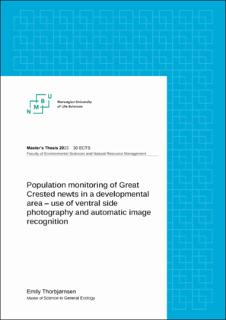| dc.description.abstract | 1. Amphibian species all over the world are in a decline due to climate change as well as human activities. To mitigate negative impacts on amphibians, especially in urban development areas, it is important to understand how human development impact the populations.
2. The goal of the study was to document the development of the Great Crested newt (Triturus cristatus) population in a developmental area with varying degrees of considerations to mitigate negative impacts on newts taken during the construction phase. The main objectives of the study were to assess changes during the last 10 years (2013-2022) in: 1) population size in the ponds based on (a) maximum count per capture session and (b) recaptures of identified individuals and capture-mark-recapture models; 2) average body mass of adults, to assess if there are indications of a decline 3) age structure. Based on identification of individuals from photos of ventral side patterns, I also investigated if there was evidence of movements between ponds, and the relative performance of manual versus automatic methods for individual recognition.
3. The data was collected from two ponds, Kjeller Gård pond (2013-2022) and Lundbydammen (2016-2022) The animals were captured in Ortmann-traps during several trapping sessions each year in each pond and the animals were photographed and weighed. The pictures were sorted manually and by use of the software Zooracle.
Population size for the population Kjeller pond - based on capture-“mark” (i.e., photo)-recapture data of adult females and males - was estimated with Jolly-Seber population models; both closed and open population models.
4. Estimations of the population size in the Kjeller pond showed a decrease in population size from 2013 to 2016, an increase towards 2019 and a decrease from 2019 to 2022. A total decline from 2013 to 2022.
Estimated population size from capture-mark-recapture models were consistently larger than the maximum number of individuals trapped during any trapping night (capture event), irrespective of year. However, the relative difference between maximum number of newts captured and estimated number of individuals was not constant among years. Thus, individual identification and capture-mark-recapture modelling is required to give reliable estimates of population size.
The average body mass of the animals was shown to decrease from 2016 to 2022, and the females had a larger decline rate than the males.
There was a larger population of recaptures than new animals, but there was no recruitment failure to either of the populations for Kjeller gård pond or Lundbydammen.
There was only one observation of movements between the ponds, and only in this direction from Kjeller gård pond to Lundbydammen.
Manual identification of the animals for recapture mark recapture proved the most effective in this study. Manual recognition identified more than twice as many animals as Zooracle.
5. The population in both ponds seems to have been affected by human activity. The populations had a negative development, and active measures should be taken to prevent further decline in the populations. | |


